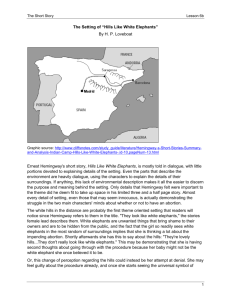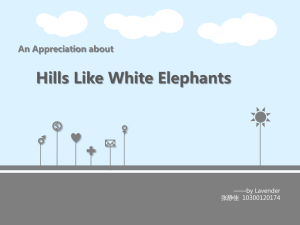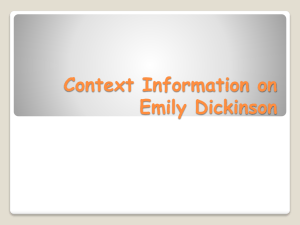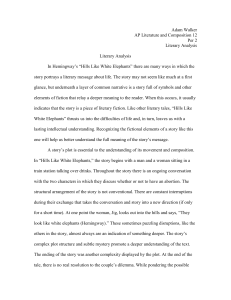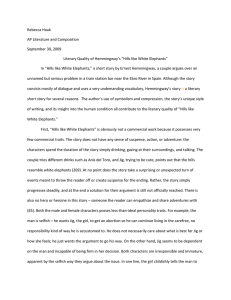lit choice board part 1
advertisement
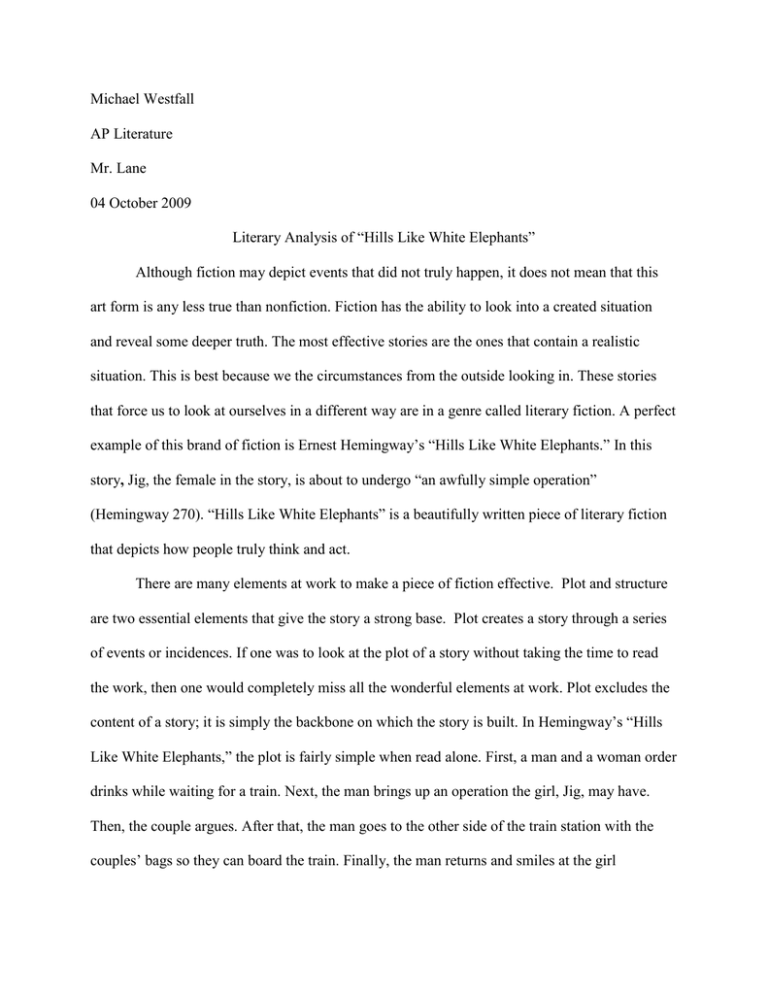
Michael Westfall AP Literature Mr. Lane 04 October 2009 Literary Analysis of “Hills Like White Elephants” Although fiction may depict events that did not truly happen, it does not mean that this art form is any less true than nonfiction. Fiction has the ability to look into a created situation and reveal some deeper truth. The most effective stories are the ones that contain a realistic situation. This is best because we the circumstances from the outside looking in. These stories that force us to look at ourselves in a different way are in a genre called literary fiction. A perfect example of this brand of fiction is Ernest Hemingway’s “Hills Like White Elephants.” In this story, Jig, the female in the story, is about to undergo “an awfully simple operation” (Hemingway 270). “Hills Like White Elephants” is a beautifully written piece of literary fiction that depicts how people truly think and act. There are many elements at work to make a piece of fiction effective. Plot and structure are two essential elements that give the story a strong base. Plot creates a story through a series of events or incidences. If one was to look at the plot of a story without taking the time to read the work, then one would completely miss all the wonderful elements at work. Plot excludes the content of a story; it is simply the backbone on which the story is built. In Hemingway’s “Hills Like White Elephants,” the plot is fairly simple when read alone. First, a man and a woman order drinks while waiting for a train. Next, the man brings up an operation the girl, Jig, may have. Then, the couple argues. After that, the man goes to the other side of the train station with the couples’ bags so they can board the train. Finally, the man returns and smiles at the girl Westfall 2 (Hemingway 268-272). If you were to read this plot in isolation the entire beauty of this story would be lost. Conflict is essential to plot and structure. The conflict is the central clash of ideals or actions in a story. The main conflict in “Hill Like White Elephants” is whether or not Jig is going to have an operation and the argument that ensues. The details of this operation have long been disputed; however, the prevailing belief is that Jig is going to have an abortion. This is because the American uses the term “letting the air in” (Hemingway 270). This phrase was often associated with abortion. Because the true nature of the operation is not expressed, and the conflict between the couple is drawn out, a great suspense is created. Suspense is what compels the reader to keep reading. Suspense is created by mysteries and dilemmas, both of which exist in “Hills Like White Elephants.” Not all mysteries and dilemmas are literary, but the ones that expose some sort of truth are, as seen in “Hills Like White Elephants.” The mystery is created by the unnamed operation; the dilemma is whether or not Jig should undergo the operation. Both of these elements have been created to force the reader to look inside themselves and ask “What would I do?” Questions such as thee make “Hills Like White Elephants” so successful as a piece of literary fiction. Point of view is the most effective element in “Hill Like White Elephants.” Point of view is who tells the story, and how the story is told. When deciding what point of view is being used the reader must ask the questions “Who is telling the story?” and “How much does the story teller know?” Point of view, like literary and commercial fiction, runs on a spectrum, and is not clearly defined. The point of view from which “Hill Like White Elephants” is told is the objective point of view. The objective point of view is the perspective in which the narrator is like a camera, depicting only what can be seen and heard. In “Hills Like White Elephants” only Westfall 3 dialogue and actions are used to tell the story. The story is written below a fourth grade reading level, yet “Hills Like White Elephants” has such deep meaning and lasting power. So much is said by the characters in so few words. For example, when the American, the male in the relationship, tells Jig to do what she wants regarding the operation (Hemingway 271); he really wants Jig to have the abortion, but the American does not want to feel guilty. Through examples such as this Hemingway has exposed truths about the human condition. All of these elements combine into one complex story; a story such as this does not happen by coincidence. Hemingway wrote “Hills Like White Elephants” with an artistic goal in mind. Point of view is the literary tool that Hemingway uses to express this goal. “Hills Like White Elephants” is a very literary piece of fiction. It possesses many of the essential criteria necessary for a literary work. “Hills Like White Elephants” is a short story, which by nature is a classically literary work. “Hills Like White Elephants” was clearly written with an artistic goal because it reveals that one may say one thing, and even think one means it, when actually he or she means quite the opposite. This story also contains suspense that is very much the essence of a literary work because it creates the question “Why is Jig or the American acting in this way?” Finally, the point of view in which “Hills Like White Elephants” is told creates many questions while generating very few answers. The point of view adds many layers to the story: “What is the operation?”; “Do Jig and the American truly love and know each other?”; “Will Jig have the abortion if that is what the operation is?” All of these layers and more are created by the ambiguous nature of the text created by the point of view from which the story is told. However, it is not to say that the story is poorly written and by some chance creates these many dimensions. “Hills Like White Elephants” is a literary work that was written with artistic intentions. Westfall 4 Works Cited Hemingway, Ernest. "Hills Like White Elephants." Perrine's Literature. Eds. Thomas R. Arp and Greg Johnson. Boston: Thomson Wadsworth, 2006. 268-72.

